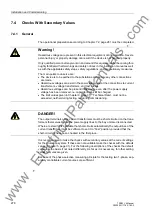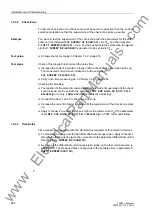
Checks With Secondary Values
283
7SS52 V4 Manual
C53000-G1176-C182-3
7.4.3
Differential Current Monitoring
7.4.3.1
busbar-selective Protection
To check the busbar-selective protection, the busbar-selective protection must be set
more sensitive than the check zone so that the supervision of the differential current
of the check zone picks up later.
Example
You want to test the supervision for the busbar-selective protection with the parame-
ters for the differential current threshold
(
) =
0.2
I/I
no
and
the delay time (
/
CU
) =
2.0
s.
For the check zone the parameter for the differential current threshold
(
CU
)is assumed to be set to
0,8
I/I
no
.
Test setup
Arrange the test setup as in Chapter 7.4.2, page 279.
Test steps
To make the differential current supervision block the protection, set it with the pa-
rameter
(
CU
) to
On
.
Set the parameters for the differential current threshold
(
) as desired.
Set the parameters for the overcurrent thresholds
(
XX13/CU
) for the con-
cerned bays to
0
.
If the parameter
(
) is set to
block
, carry out the fol-
lowing 3 steps:
−
Connect the bays 1 and 2 to different bus zones.
−
Increase the current I
1
in feeder 1 slowly until the annunciation of the differential
current supervision signals that it has picked up. The current must correspond to
the pickup threshold set in parameter
(
6308/CU
). Now the bus
is blocked. Even if I
1
is further increased, there is no tripping.
−
Apply to feeder 2 a current 4 times as high as the rated current I
N
. The protection
system now switches off the current in feeder 2.
The last 2 test steps guarantee that the supervision of the differential current is
busbar-selective.
If the parameter
(
CU
) is set to
alarm only
without
protectionblocking, carry out the following 3 steps:
−
Connect the bays 1 and 2 to the same bus zone.
−
Increase the current I
1
in feeder 1 slowly until the differential current signals that
it has picked up. The current must corespond to the set pickup threshold in pa-
rameter
(
CU
).
−
Apply to feeder 2 a current 4 times as high as the rated current I
N
. By doing this
the protection system now switches off the current in the feeders 1 and 2.
www
. ElectricalPartManuals
. com
















































